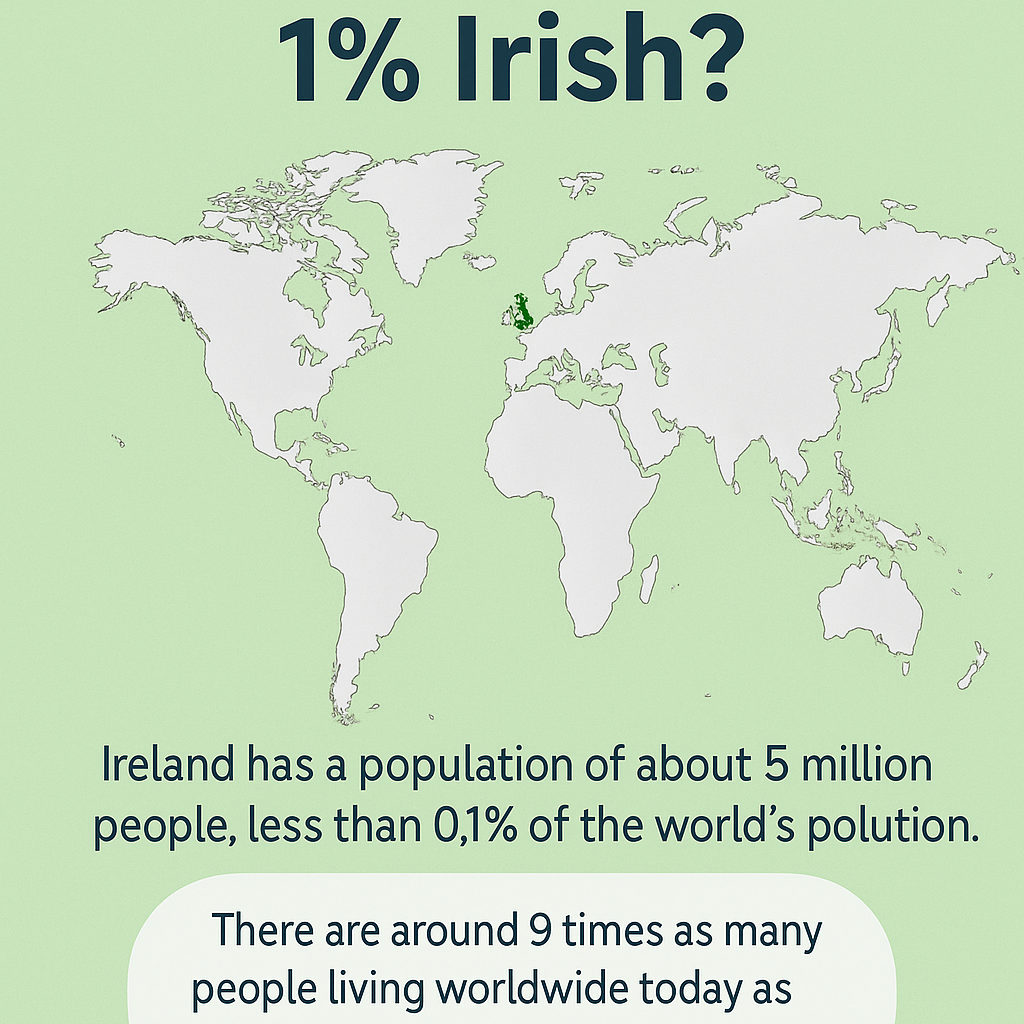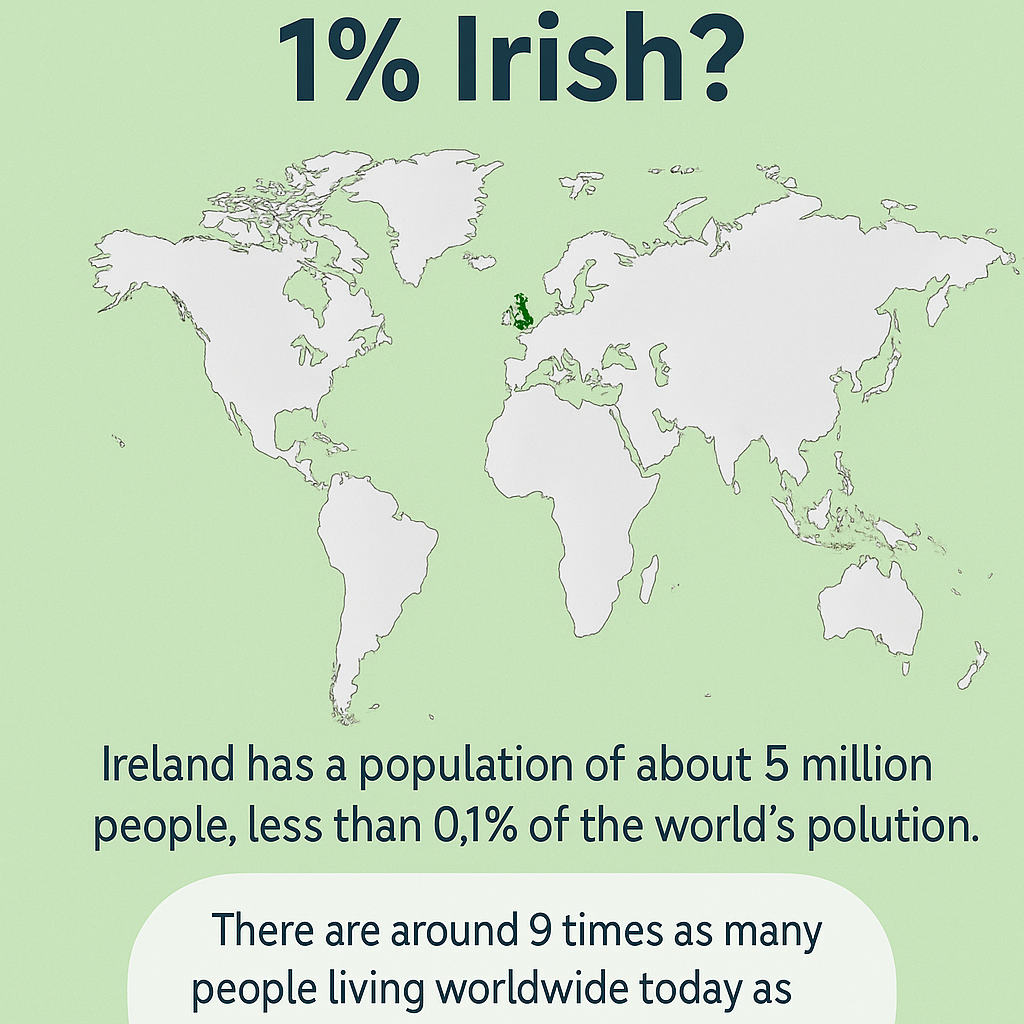
The whimsical notion that “everyone is 1% Irish” is a charming sentiment, often expressed with a wink and a nod, particularly around St. Patrick’s Day.
It speaks to the widespread admiration and cultural influence of the Irish people across the globe. But, like many such generalizations, it begs the question: is there any truth to it?
This blog delves into the fascinating world of Irish ancestry, genetics, and identity to explore this very question, while addressing other frequently asked questions about Irish heritage.
The idea likely stems from the extensive Irish diaspora, the millions who emigrated from Ireland over centuries, scattering their descendants across continents.
This global movement has undoubtedly woven threads of Irish heritage into the fabric of many nations. However, to claim that everyone carries at least 1% Irish ancestry is a significant oversimplification of complex genetic and historical realities.
Is it possible to be 100% Irish?
The concept of being “100% Irish” is more nuanced than it might initially appear. Genetically speaking, the population of Ireland, like most long-inhabited regions, has been shaped by migrations and intermingling over millennia. The earliest settlers of Ireland were not who we would identify as “Irish” today. Over time, various groups arrived, including Celts, Vikings, Normans, and others, all contributing to the genetic makeup of the modern Irish population.
Therefore, while someone might identify culturally and by nationality as Irish, their genetic ancestry is likely a blend of these historical influences. However, if we consider someone born on the island of Ireland to parents and grandparents who were also born and raised in Ireland, with a strong cultural connection to their Irish heritage, then in a cultural and national sense, they could certainly be considered 100% Irish.
What percent of people are Irish?
Determining the exact percentage of people worldwide who have some degree of Irish ancestry is challenging. Millions across the globe identify as Irish or having Irish heritage, particularly in countries like the United States, Canada, Australia, and the United Kingdom. However, quantifying this as a strict percentage of the global population is difficult due to varying definitions of “Irish” ancestry and the limitations of genealogical records and genetic testing on a global scale.
While a precise figure is elusive, it’s safe to say that the number is significant, reflecting the impact of Irish emigration throughout history. However, it’s far from encompassing the entire global population, making the “everyone is 1% Irish” claim statistically improbable.
Does everyone have a little bit of Irish in them?
The answer to “Does everyone have a little bit of Irish in them?” is a resounding no. While the Irish diaspora is widespread, human populations have largely developed within specific geographical regions. Genetic studies show that ancestry is strongly tied to these origins. While there has been migration and intermingling throughout history, it hasn’t been so pervasive as to suggest a trace of Irish DNA in every single person on Earth.
The idea likely gains traction from the cultural visibility and positive associations with being Irish. However, from a genetic standpoint, the vast majority of people whose families have deep roots in regions far from Ireland (e.g., East Asia, sub-Saharan Africa, indigenous populations of the Americas) would not have Irish ancestry.
What DNA do most Irish have?
Genetic research has shed light on the DNA do most Irish have. The predominant Y-DNA haplogroup (passed from father to son) in Ireland is R1b-M269, and specifically its subclade R-M222, often referred to as the “Northwest Irish Modal Haplotype.” This haplogroup is very common in Western Europe, particularly in the British Isles and Iberia, suggesting ancient shared ancestry.
Mitochondrial DNA (mtDNA), passed down through the maternal line, shows a more diverse range of haplogroups, reflecting the various migrations and settlements that have occurred in Ireland over millennia. Studies indicate that the genetic makeup of the Irish population is a blend of these ancient migrations, with strong links to other populations in Western Europe, particularly those with Celtic and Atlantic seaboard ancestry.
How much Irish DNA for citizenship?
The requirements for Irish citizenship are based on nationality and descent, not a specific percentage of Irish DNA. If you have a parent or grandparent who was an Irish citizen (born in Ireland or registered as an Irish citizen), you may be entitled to Irish citizenship, regardless of your specific genetic makeup. The focus is on legal lineage and connection to the Irish nation.
Is anyone 100% Celtic?
The concept of being “100% Celtic” is similar to the complexities of being “100% Irish” genetically. “Celtic” refers to a cultural and linguistic group that spread across Europe in ancient times. While the Irish people have a strong Celtic heritage, with the Irish language being a surviving Gaelic Celtic language, the genetic ancestry of populations in Celtic regions is a blend of various pre-Celtic and Celtic migrations, as well as subsequent influences. Therefore, while someone might strongly identify with Celtic culture and heritage, their genetic makeup is unlikely to be exclusively derived from ancient Celtic populations.
Can you be 100% of one ethnicity?
The idea of being “100% of one ethnicity” is also complex and often debated. Ethnicity is a multifaceted concept encompassing shared culture, language, ancestry, and identity. While someone might strongly identify with a single ethnicity due to their upbringing and cultural immersion, their genetic ancestry is often a mix of different populations due to historical migrations and intermarriage. In a purely genetic sense, it’s rare for an individual to have ancestry exclusively from one single, isolated population group.
How many people are 100 in Ireland?
The number of centenarians (people aged 100 or older) in Ireland, like in most countries, is a relatively small percentage of the overall population. While Ireland has a reputation for longevity and a healthy lifestyle, the number of people reaching 100 is not a majority. Recent statistics indicate that there are several hundred centenarians living in Ireland.
How much Irish do you have to be to be considered Irish?
The criteria for being considered Irish are primarily based on nationality and cultural identity, rather than a specific percentage of genetic ancestry. Someone born in Ireland is generally considered Irish. Additionally, those who have acquired Irish citizenship through descent or naturalization are also considered Irish. A strong cultural connection to Ireland, its traditions, and perhaps even the Irish language, can also contribute to one’s sense of Irish identity, regardless of their exact genetic heritage.
What percentage of Ireland is fluent in Irish?
While the Irish language (Gaeilge) is one of the official languages of Ireland, the percentage of the population that is fluent in it is relatively low. According to recent surveys, a small percentage of the population (around 1-2%) uses Irish as a daily language outside of the education system. However, a larger percentage has some knowledge of the language, having studied it in school. Efforts are ongoing to promote and revitalize the use of Irish in daily life.
Is everyone 1% irish reddit:
Discussions on platforms like Is everyone 1% irish reddit often reflect the anecdotal nature of this claim. Users share personal stories of discovering distant Irish ancestry, contributing to the perception of a widespread connection. However, these discussions also highlight the difference between a distant ancestor and a significant percentage of one’s genetic makeup. While many might find a distant Irish relative in their family tree, this doesn’t equate to everyone having a measurable 1% of Irish DNA.
Is Irish an ethnicity or nationality:
Irish can be both an ethnicity and a nationality. It is a nationality for those who hold citizenship of Ireland. It is also an ethnicity for people who share a common cultural heritage, including language (though not universally spoken), traditions, music, and a sense of shared history connected to the island of Ireland and its diaspora. Someone can be of Irish ethnicity without being an Irish national, and vice versa, though the two often overlap.
Irish genetic traits:
While there isn’t a single defining set of Irish genetic traits that distinguishes all Irish people, certain genetic markers are more prevalent in the Irish population due to their history and ancestral origins, as mentioned with the R1b-M269 and R-M222 haplogroups. These are linked to broader patterns in Western Europe. There are also some genetic conditions that are more common in Ireland due to founder effects (where a genetic mutation is passed down through a small founding population).
Irish people physical characteristics:
There are no singular Irish people physical characteristics. Due to the various historical migrations and settlements in Ireland, the population exhibits a range of physical appearances. Stereotypes often include fair skin, red hair, and blue or green eyes, and while these traits are present, they are not exclusive to or universal among the Irish population. You will find people with dark hair and eyes as well.
Irish celebrities:
The global influence of Irish celebrities in various fields, from acting (e.g., Colin Farrell, Saoirse Ronan) and music (e.g., U2, Hozier) to sports and literature, contributes to the widespread awareness and admiration of Irish culture. Their success helps to project an image of Irish talent and achievement onto the world stage.
Black Irish:
The term “Black Irish” is an interesting and often debated one. It doesn’t refer to people of African ancestry in Ireland. Instead, it’s a colloquial term sometimes used to describe Irish people with dark hair and eyes, often with darker complexions than the stereotypical fair Irish look. The origins of the term are uncertain, with theories ranging from descent from Spanish Armada survivors to pre-Celtic Iberian ancestry. It’s important to note that “Black Irish” is a cultural descriptor and not a scientifically recognized genetic category.
Conclusion:
While the sentiment behind the idea that “everyone is 1% Irish” is warm and reflects the widespread admiration for Irish culture, the genetic and historical realities tell a different story.
Irish ancestry is significant globally due to emigration, but it is far from universal. Being Irish is primarily a matter of nationality, cultural identity, and often a connection to the island itself, rather than a specific percentage of DNA.
The genetic heritage of the Irish population is a rich tapestry woven from various historical migrations, linking them to broader patterns in Western Europe. So, while you might not be 1% Irish, the global influence and enduring spirit of the Irish people are something that can be appreciated by all.







